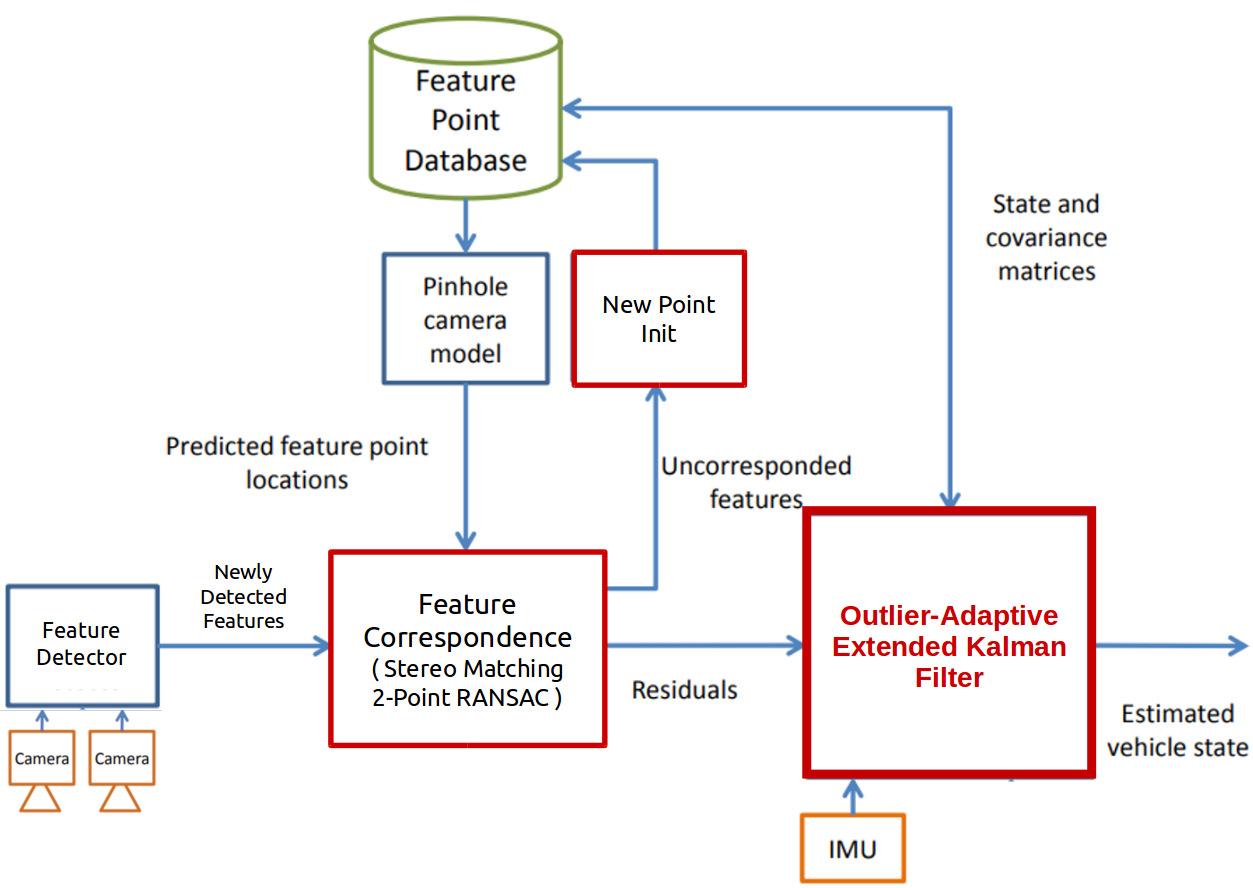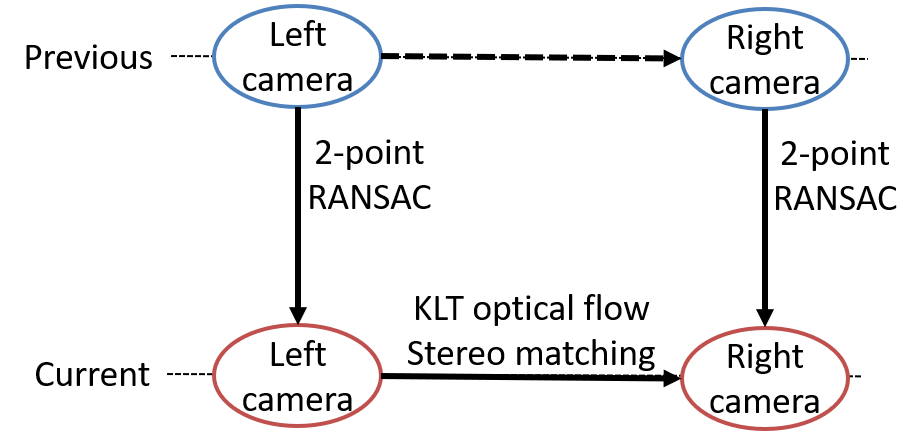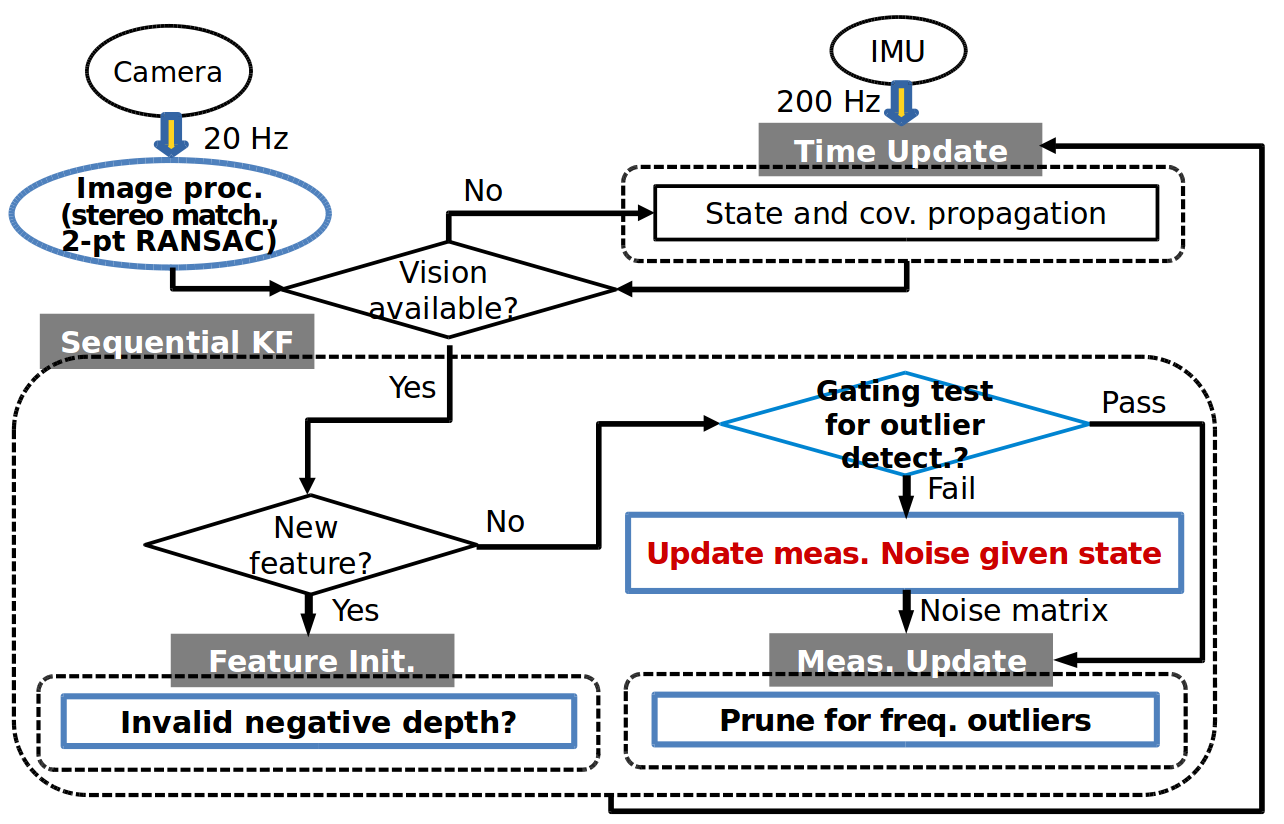With the advent of unmanned aerial vehicles (UAVs), a major area of interest in the research field of UAVs has been vision-aided inertial navigation systems (V-INS). In the front-end of V-INS, image processing extracts information about the surrounding environment and determines features or points of interest. With the extracted vision data and inertial measurement unit (IMU) dead reckoning, the most widely used algorithm for estimating vehicle and feature states in the back-end of V-INS is an extended Kalman filter (EKF). An important assumption of the EKF is Gaussian white noise. In fact, measurement outliers that arise in various realistic conditions are often non-Gaussian. A lack of compensation for unknown noise parameters often leads to a serious impact on the reliability and robustness of these navigation systems. To compensate for uncertainties of the outliers, we require modified versions of the estimator or the incorporation of other techniques into the filter. The main purpose of this paper is to develop accurate and robust V-INS for UAVs, in particular, those for situations pertaining to such unknown outliers. Feature correspondence in image processing front-end rejects vision outliers, and then a statistic test in filtering back-end detects the remaining outliers of the vision data. For frequent outliers occurrence, variational approximation for Bayesian inference derives a way to compute the optimal noise precision matrices of the measurement outliers. The overall process of outlier removal and adaptation is referred to here as “outlier-adaptive filtering”. Even though almost all approaches of V-INS remove outliers by some method, few researchers have treated outlier adaptation in V-INS in much detail. Here, results from flight datasets validate the improved accuracy of V-INS employing the proposed outlier-adaptive filtering framework.
- V-INS
- UAV
- EKF
- IMU
- camera vision
- computer vision
- image processing
- outlier rejection
- adaptive filtering
- sensor fusion
- navigation
1. Introduction
9]. Such outliers have many anomalous causes. They arise due to unanticipated changes in system behavior (e.g., temporary sensor failure or transient environmental disturbance) or unmodeled factors (e.g., human errors or unknown characteristics of intrinsic noise). As an example of measurement outliers in many navigation systems, either computer vision data contaminated by outliers or sonar data corrupted by phase noise lead to erroneous measurements. Process outliers also occur by chance. Inertial measurement unit (IMU) dead reckoning and wheel odometry as a proxy often generate inaccurate dynamic models in visual-inertial odometry (VIO) and SLAM algorithms, respectively. Without accounting for outliers, the accuracy of the estimator significantly degrades, and control systems that rely on high-quality estimation can diverge.
Starting from the architecture of the existing vision-aided inertial navigation system, this paper more focuses on contributing to the development of red boxes in Figure 1.

Figure 1. A block diagram of the vision-aided inertial navigation system employing the outlier-adaptive filtering.
outlier-adaptive filtering.
2. Outlier Rejection in Image Processing Front-End

Figure 2. Close loop steps of outlier rejection in image processing front-end.
3. Outlier Adaptation in Filtering Back-End
Even though image processing front-end removes outliers by tracking, stereo matching, and 2-point RANSAC, some outlier features still survive and enter the filter as inputs. This section explains the outlier rejection procedure in filtering back-end.
This section summarizes and describes the implementation of the proposed method. Figure 3 illustrates a flow chart of the overall process of the outlier-adaptive filtering approach for V-INS. For the robust outlier-adaptive filter presented in this paper, the blue boxes in Figure 3 are extended from the figure in [
25].

Figure 3. A flow chart of the overall process of the outlier-adaptive filtering.
4. Discussion
This entry has presented practical outlier-adaptive filtering for a vision-aided inertial navigation systems (V-INS) and evaluated its performance with flight datasets testing. In other words, this study develops a robust and adaptive state estimation framework for V-INS under frequent outliers occurrence. In the image processing front-end of the framework, we propose the improved utilization of outlier removal techniques. In filtering back-end, for estimating the states of V-INS with measurement outliers, we implement a novel approach of the outlier-robust extended Kalman filter (EKF) to V-INS, for which we derive iterative update steps for computing the precision noise matrices of vision outliers when the Mahalanobis gating test detects remaining outliers.
The primary goals of future work are listed as follows. Since an inertial measurement unit (IMU) is also a sensor, it could generate outliers in V-INS. With accounting for the process outliers, the accuracy and robustness of the estimator would be improved. If we distinguish process outliers from IMU sensors with measurement outliers from vision data, the extended outlier-robust EKF [
62] may handle the unknown correlations in V-INS.
This entry showcases the approaches using stereo cameras but is also suitable for monocular V-INS and employable to other filter-based V-INS frameworks. We test benchmark flight datasets to validate the reliability and robustness of this study, but additional validating with other flight datasets or real-time flight tests would help to prove its more robustness. In addition, we can operate unmanned aerial vehicles (UAVs) stacked the navigation algorithms in this study and a controller-in-the-loop. The use of the controller-in-the-loop could be a more important validation criteria due to the potential for navigation-controller coupling. The research objectives and contributions presented here will remarkably advance the state-of-the-art techniques of vision-aided inertial navigation for UAVs.
This study showcases the approaches using stereo cameras but is also suitable for monocular V-INS and employable to other filter-based V-INS frameworks. We test benchmark flight datasets to validate the reliability and robustness of this study, but additional validating with other flight datasets or real-time flight tests would help to prove its more robustness. In addition, we can operate unmanned aerial vehicles (UAVs) stacked the navigation algorithms in this study and a controller-in-the-loop. The use of the controller-in-the-loop could be a more important validation criteria due to the potential for navigation-controller coupling. The research objectives and contributions presented here will remarkably advance the state-of-the-art techniques of vision-aided inertial navigation for UAVs.
References
- Kyuman Lee; Eric N. Johnson; Robust state estimation and online outlier detection using eccentricity analysis. 2017 IEEE Conference on Control Technology and Applications (CCTA) 2017, ., 1350-1355, 10.1109/ccta.2017.8062646.
- Gabriel Agamennoni; Juan I. Nieto; Eduardo Nebot; An outlier-robust Kalman filter. 2011 IEEE International Conference on Robotics and Automation 2011, ., 1551-1558, 10.1109/icra.2011.5979605.
- Bernd Kitt; Andreas Geiger; Henning Lategahn; Visual odometry based on stereo image sequences with RANSAC-based outlier rejection scheme. 2010 IEEE Intelligent Vehicles Symposium 2010, ., 486-492, 10.1109/ivs.2010.5548123.
- Ke Sun; Kartik Mohta; Bernd Pfrommer; Michael Watterson; Sikang Liu; Yash Mulgaonkar; Camillo J. Taylor; Vijay Kumar; Robust Stereo Visual Inertial Odometry for Fast Autonomous Flight. IEEE Robotics and Automation Letters 2018, 3, 965-972, 10.1109/lra.2018.2793349.
